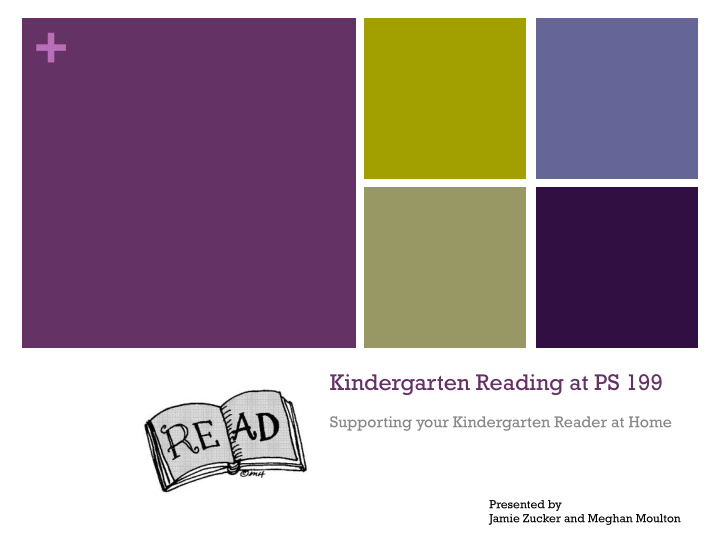



+ Kindergarten Reading at PS 199 Supporting your Kindergarten Reader at Home Presented by Jamie Zucker and Meghan Moulton
+ What is Reading Workshop? Students gain a love of reading and appreciation of books through daily Reading Workshop . During this time, students learn the features of books, concepts of print, decoding, and comprehension skills to help them become successful, lifelong readers. A typical Reading Workshop looks like this: • Minilesson with Active Engagement (5-10 minutes) • Independent Reading (10-25 minutes) • Partner Reading (10-20 minutes) There are many additional reading opportunities throughout the • Share (5 minutes) day, such as: read alouds, shared reading, word study.
+ How do kids learn to read? n Integration of three cuing systems: n Meaning n Structure n Visual
+ Reading “Just Right Books” There are three main pieces of teaching your child to read: Comprehension: The ultimate goal of reading! 1. Accuracy: The ability to read the words on the page. 2. Fluency: Being able to read text accurately and with 3. expression. *Comprehension is the most important piece of the puzzle! With out the comprehension, the other two don’t matter! It all comes down to what makes sense! *
+ Whatever you do… n DO NOT TEACH YOUR CHILD TO SOUND OUT WORDS! THIS IS NOT HOW WE TEACH READING AND IT WILL ONLY CONFUSE YOUR CHILD AND HOLD THEM BACK! THE PRINT STRATEGIES THAT WE ARE ABOUT TO INTRODUCE YOU TO WILL HELP YOUR CHILD TO DECODE! FOR EXAMPLE: IF YOU ARE TRYING TO FIGURE OUT WHAT THE WORD “LIGHT” IS, IF YOU SOUND OUT THE WORD LETTER BY LETTER, YOU WILL NEVER FIGURE OUT THE WORD.
+ Levels A/B Skills/Strategies Uses cover/title/illustrations to get • ready to read Uses illustrations as a source of • information to figure out words Moves from left to right when reading • Uses one to one matching • Uses and locates known words • Thinks about what makes sense • Carries the pattern from one page to • the next with prompting
+ Level C Skills/Strategies Follows multiple lines of print on a page • Uses the beginning letters in a word along with • meaning to solve an unknown word Independently follows more advanced patterns • across pages Begins to read with fluency • Retells/summarizes story with important details • Begins to implement self monitoring strategies • Does is look right? • Does it sound right? • Does it make sense? •
+ Level D Skills/Strategies Begins to use eyes, rather than • finger, to track print Uses the final and middle letters • letters in a word along with meaning to solve an unknown word Continues to self monitor reading • Uses more advanced decoding • strategies (chunking, looking for a smaller word inside, skip it and go back) Retells and summarizes the story • with more detail
+ Level E Skills/Strategies • Notices errors and self corrects using all sources of information • Makes inferences about the story • Begins to read with even more fluency and phrasing • Makes connections to the text • Decoding strategies at this level may include: looking for familiar word patterns, changing the vowel sound
+ Level F Skills/Strategies • Recognizes and reads more difficult sight words automatically • Reads punctuation • Retells and summarizes keeping story events in order • Makes inferences about story content with a clear explanation • Makes explicit connections to the text with supportive evidence • Uses a multitude of decoding strategies
+ “But my child can read Harry Potter!” n Reading is the of process making meaning of written text n Decoding vs. Reading n Word callers often focus so much on letters and decoding that they are unable to fully comprehend the text (therefore, they are not actually “reading”). n In order to really be able to read higher level texts, students must clearly be able to identify plot, setting, key characters, complex themes, character relationships, etc.
+ The Importance of Rereading Each time we read, we can read with a different lens. Students can focus on: n Fluency n Word recognition n Comprehension n Building confidence as a reader n Thinking about different characters n Sharing ideas with partners n Learning something new n E N J O Y M E N T !!!
+ Supporting Your Child at Home n Read every night—”Just Right” books and storybooks n Practice reading sight words n Work with your child on comprehending what they have read n Coach your child to use “word tackling strategies” n Read everything you see!
Sight Words Comprehension Questions • Look at the cover and predict. • What might this book be about? • What happened in the story? • Who are the characters in the story? • How did this story make you feel? • What was your favorite/least favorite part? Why? • Who was your favorite character? Why?
+ Resources for leveled books similar to the ones found at school: n Reading A-Z Readinga-z.com n Brand New Readers Brandnewreaders.com n Scholastic Scholastic.com * Search book wizard on the scholastic website and enter the guided reading level (same as your child’s reading level)
Recommend
More recommend